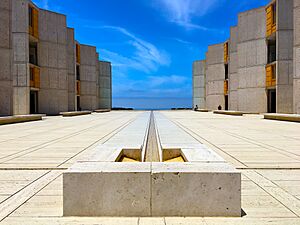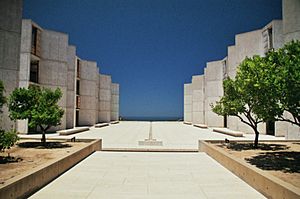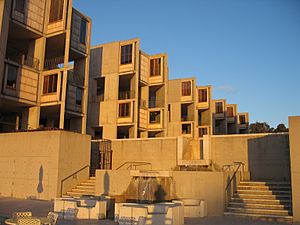Salk Institute for Biological Studies facts for kids

Salk Institute for Biological Studies in July 2019
|
|
| Established | December 28, 1960 |
|---|---|
| Research type | Basic |
|
Field of research
|
neuroscience, cancer research, aging, immunobiology, plant biology, computational biology |
| President | Gerald Joyce |
| Faculty | 48 |
| Address | 10010 N Torrey Pines Rd |
| Location | La Jolla, California, US 32°53′15″N 117°14′47″W / 32.88750°N 117.24639°W |
| 92037 | |
| Affiliations | UC San Diego |
|
Building details
|
|
| General information | |
| Type | Institutional |
| Town or city | San Diego, California, U.S. |
| Current tenants | Salk Institute |
| Named for | Jonas Salk |
| Completed | 1965 |
| Technical details | |
| Structural system | Vierendeel trusses |
| Material | Poured concrete |
| Floor count | 4 |
| Design and construction | |
| Architect | Louis I. Kahn |
| Structural engineer | August Komendant |
| Awards and prizes | American Institute of Architects Twenty-five Year Award |
The Salk Institute for Biological Studies is a famous science research center in La Jolla, San Diego, California. It's a non-profit organization that does important scientific studies. The institute was started in 1960 by Jonas Salk, who created the polio vaccine.
Today, the Salk Institute is known as one of the best places in the US for life science research. It has about 850 researchers working in 60 different groups. They focus on three main areas: molecular biology (studying tiny parts of living things), neuroscience (studying the brain), and plant biology (studying plants).
Researchers at Salk study many important topics. These include aging, cancer, diabetes, and brain diseases like Alzheimer's disease and Parkinson's disease. They also study AIDS and how the brain works with American Sign Language. The March of Dimes helped fund the institute from the beginning and still supports it.
Contents
History of the Salk Institute
Jonas Salk and architect Louis I. Kahn asked the city of San Diego for land in 1960. They received the land after people voted for it. The March of Dimes provided the first money to build the institute. Construction started in 1962, and the first scientists moved in by 1963. More buildings were added in the 1990s.
At the entrance of the institute, there's a special message honoring Jonas Salk. It says: "Hope lies in dreams, in imagination and in the courage of those who dare to make dreams into reality."
Francis Crick, who helped discover the structure of DNA, was a leading researcher here. He worked on understanding human consciousness until he passed away in 2004.
Celebrating 50 Years
In April 2010, the Salk Institute celebrated its 50th birthday. They hosted an art show with beautiful glass sculptures by artist Dale Chihuly. This event was supported by Irwin M. Jacobs, who used to lead the institute's board.
What They Study at Salk
Jonas Salk wanted the institute to be a place where new scientists could grow. He imagined a place where science and other ways of thinking could come together. He hoped it would help scientists understand life processes better.
Salk believed that by studying how cells work, scientists could find ways to prevent many diseases. For example, they hoped to create a single vaccine for many common childhood illnesses. They also wanted to find ways to fix genetic problems that cause birth defects.
Salk said he hoped the institute would help "enlarge the wisdom of man." He wanted it to free each person to be as creative as possible. The institute's design even included blackboards on the walls for scientists to share ideas.
In 1980, The New York Times described Salk's work at the institute. He studied how the immune system fights cancer and diseases like multiple sclerosis. Salk felt that creating the institute might be his most important achievement. He saw it as a place for "excellence" and "creative minds."
The institute was also the setting for the 1979 book Laboratory Life: The Construction of Scientific Facts. This book explored how scientific discoveries are made.
Amazing Architecture
The Salk Institute buildings are very special. They were designed by architect Louis I. Kahn. Jonas Salk wanted a beautiful campus to attract the best scientists. The original buildings were made a historical landmark in 1991. The entire 27-acre site is considered very important historically. It is seen as one of Kahn's most important works.
Building Design and Features
The institute has two main buildings that are exactly alike. A long, thin fountain flows between them, leading your eye towards the Pacific Ocean. The buildings are made of a special concrete that looks warm and pinkish. This concrete was made using old Roman techniques with volcanic ash.
Inside, the laboratories are designed to help scientists work together. There are no walls separating the labs on each floor. This open design encourages teamwork. The lights on the roof can even slide along tracks, showing the open and collaborative spirit of the science done here.
The buildings have a clever design to hide all the pipes and ducts. Above each laboratory floor, there's a separate "service floor." This makes it easy to change the labs without disturbing others. Strong concrete structures called Vierendeel trusses support the floors. These trusses are like ladders and allow the labs to be open without many support columns.
Originally, Kahn wanted a garden in the middle of the two buildings. But then he met landscape architect Luis Barragan. Barragan advised him to create a simple, open plaza with just a water feature. This open space is now considered the most impressive part of the design.
The Courtyard Grove

In the courtyard, there's a grove of semi-dwarf Valencia orange trees. These trees replaced earlier lime trees. The Valencia orange trees were chosen because they stay green even in the shade.
An Open Environment
The Salk Institute has a lot of open space. This symbolizes an open environment for new ideas and discoveries. The design helps scientists work alone and together, much like old monasteries were places for quiet study. The institute's design shows how Western civilization seeks truth through science.
In 2014, the Getty Conservation Institute started working with Salk. They are helping to protect the concrete and teak buildings from the ocean air.
Labs, Library, and Auditorium
Many labs and study areas are named after people who have supported the institute. There is a library on the third floor of the North building. It has current magazines, books, and computers. The Conrad T. Prebys auditorium and the Trustees' Room are in the basement of the east buildings.
Scientific Research at Salk
The institute is divided into several research units. Each unit has many scientific groups, led by a faculty member. Some of these units include:
- Plant Molecular and Cellular Biology Laboratory
- Regulatory Biology Laboratory
- Structural Biology Laboratory
- Gene Expression Laboratory
- Laboratory of Genetics
- Molecular Neurobiology Laboratory
- Cellular Neurobiology Laboratory
- Systems Neurobiology Laboratories
- Computational Neurobiology Laboratory
- Clayton Foundation Laboratories for Peptide Biology
- Molecular and Cell Biology Laboratory
- Chemical Biology and Proteomics Laboratory
- Immunobiology and Microbial Pathogenesis Laboratory
- The Renato Dulbecco Laboratories for Cancer Research
As of February 2023, Gerald Joyce is the president of the institute. The Salk Institute has 53 faculty members. Many of them are members of important scientific groups like the National Academy of Sciences.
The institute is known worldwide for its research in biology, especially in brain science and plant science. In 2009, Time magazine called Joseph R. Ecker's work on mapping the human epigenome one of the top scientific achievements of the year.
In 2008, the California government gave $270 million to the California Institute for Regenerative Medicine (CIRM). The Sanford Consortium for Regenerative Medicine, which includes the Salk Institute, received $43 million from this funding.
The institute also trains young scientists who are just starting their careers.
Important Projects
The Salk Institute is currently working on the Harnessing Plants Initiative (HPI). This project aims to make farm crops better at capturing carbon from the air. It has two main parts:
- CRoPS (CO2 Removal on a Planetary Scale): This program wants to create "Salk Ideal Plants."
- CPR (Coastal Plant Restoration)
The "Salk Ideal Plants" are special plants that are changed to have bigger, deeper roots. These roots would also have more suberin, a substance that helps store carbon in the soil.
Training Future Scientists
Even though the Salk Institute doesn't give out degrees, it has a graduate program with the nearby UC San Diego. All Salk Institute professors also teach at UC San Diego. Students can earn a PhD or an MD/PhD degree through this program.
Well-Known Scientists at Salk
Many famous scientists have worked at the Salk Institute, including:
- Joanne Chory, a leading plant scientist.
- Ursula Bellugi, who studied the brain science of American Sign Language.
- Joseph R. Ecker, an expert in how genes are controlled in plants and animals.
- Terrence Sejnowski, a well-known computational neuroscientist.
- Ronald M. Evans, who won the Lasker Award for his work in molecular biology.
- Fred H. Gage, a highly recognized neuroscientist.
- Tony Hunter, who discovered how certain proteins are changed in cells.
- Juan Carlos Izpisua Belmonte, a famous developmental biologist.
- Katherine Jones, an expert in proteins who found proteins needed for HIV gene expression.
- Charles F. Stevens, a neuroscientist known for studying the brain's structure.
- Reuben Shaw, a cancer researcher and director of Salk's Cancer Center.
Nobel Prize Winners
As of 2024, the Salk Institute has one Nobel Prize winner on its faculty: Elizabeth Blackburn. Four other Nobel winners who worked at Salk have passed away: Francis Crick, Robert W. Holley, Renato Dulbecco, and Sydney Brenner. Also, five scientists who trained at Salk have gone on to win the Nobel Prize.
Past Scientists at Salk
- Stephen Heinemann (1939–2014), an early neuroscientist.
- Francis Crick (deceased), Nobel laureate for his work on DNA.
- Leslie Orgel (deceased), a former senior researcher.
- Marguerite Vogt (deceased), a virologist.
- Leo Szilard (deceased), a nuclear physicist who invented a cancer treatment.
- Renato Dulbecco (deceased), Nobel laureate for his work on viruses and cells.
- Melvin Cohn (deceased), a co-founder and pioneer in gene regulation.
- Elizabeth Blackburn (former president of Salk Institute), Nobel laureate for her work on telomeres.
- Sydney Brenner (deceased), Nobel laureate for his work with a tiny worm.
- Roger Guillemin, a co-founder and Nobel laureate for his work on hormones.
- Inder Verma, a cancer biologist and editor of a science journal.
Images for kids
See also
 In Spanish: Instituto Salk para niños
In Spanish: Instituto Salk para niños
- Broad Institute
- Cold Spring Harbor Laboratory
- Laboratory Life, a book about science based on research at Salk.
- San Diego Historical Landmarks in La Jolla, California
- University of California, San Diego
- Whitehead Institute







